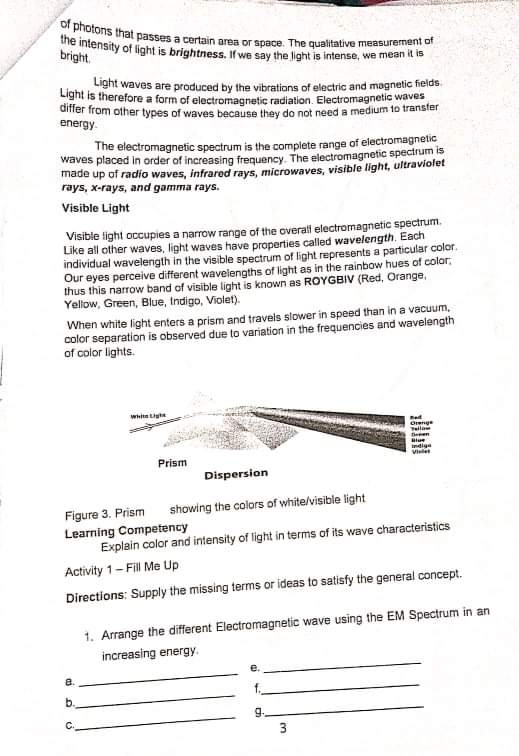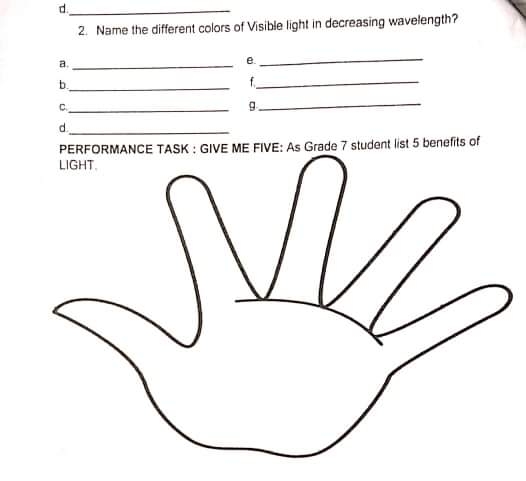Help me please, if you were to ask what will be your answer? Kindly answer this with detailed and clear explanation. Thank you.
Background of the study The Bible gives a vivid account of the origin of light. In the beginning there was darkness. But the Creator commanded "Let there be light!" and there was light. But what is light? Man has pondered over the nature of light since the start of the civilization. Plato and Euclid believed that light was something given off by the eye, making things visible when struck by it. Aristotle thought of light as something nonmaterial that goes through space between the eye and the object seen. Pythagoras considered light to be very fine particles coming from a luminous object. The Greek philosopher, Empedocles, asserted light to be a very high- speed wave. Theories about Light Sir Isaac Newton believed that light behaves like a particle while Christian Huygens believed that light behaves like a wave. A third scientist, Louie de Broglie come up with what is now known as the Dual - nature of Light He explained that light can be a particle and can also a wave. To complete our knowledge about the nature of light, James Clerk Maxwell proposed the Electromagnetic Theory of Light. How is Shadow formed? You may have experienced playing with shadows and creating the shapes of some objects by projecting shadows of your hands on a wall. You usually do this with a lighted candle as your light source. Ashadow is formed when you block the path of light. Generally, light does not bend around corners so whenever there is an object that blocks some of the light, a shadow is created. This shows that the light travels in straight paths However, diffraction or bending of light happens around edges equal or smaller then the wavelength of light. The ray model of tight shows that light travels in straight paths. Although light follows a straight path from its source, it can be slowed down and scattered by objects placed in its path, Transmission of Light Light can pass through, bounce off, or be absorbed by matter. Light easily passes through air, It can pass through glass and water, Matter that transmits most of the light that strikes it is said to be transparent. Transparent materials allow light to pass through so you can clearly see objects through them like glass and clear plastic. Other materials like frosted glass allow some light to pass through but you cannot clearly see objects through them. These materials are translucent like frosted or tinted glass and wax paper. Matter that reflects or absorbs but does not transmit light is said to be opaque like milk, aluminium foil and mirror. Most solids are opaque. You cannot see through them. Speed of Light Light travels with a speed of about 300 million m/s (about 186 000 mils) in a vacuum, At this amazing speed, light from the sun takes only 8 minutes to travel to Earth, Nothing travels faster than the speed of light. When light passes through a medium it travels more slowly. The speed of light varies depending on the medium through which it passes. In air, light travels about 99% of its speed in space, In water it slows down to about 225000 000 mis and through glass, the speed of light decreases to about 196000 000m/s, Table shows the speed of light in different mediums Intensity of Light Probably you have noticed that light appears to be brighter when you are close to it and dimmer when you are farther away. It is because the brightness of light depends on how far you are from the source, The particle nature of light explains why the brightness or intensity of light changes with distance. Particles of light travel in a straight line from a light source. At the source, all the particles of light are closer together. Since the intensity of light is related to the number of photons, light is brighter when you are closer to the source, As the distance from the source of light increases, the light spreads out and becomes dimmer. The quality that measures the amount of light illuminating a surface is called intensity. The intensity of light depends upon the amount of light or the number THE ELECTROMAGNETIC SPECTRUM Radio Microwave Infrared Visible Ultraviolet X-ray Gamma A 10 102 102 10 1010 10 Wavelength in centimeters About the size of. Buildings Humans Honey Bee Pinhead Protorgans Molecules Atoms Atomic N Figure 2. The Electromagnetic Spectrumof photons that passes a certain prea or space. The qualitative measurement of bright the intensity of light is brightness. If we say the light is intense, we mean it is Light waves are produced by the vibrations of electric and magnetic fields Light is therefore a form of electromagnetic radiation. Electromagnetic waves energy differ from other types of waves because they do not need a medium to transfer The electromagnetic spectrum is the complete range of electromagnetic waves placed in order of increasing frequency. The electromagnetic spectrum is made up of radio waves, infrared rays, microwaves, visible light, ultraviolet rays, x-rays, and gamma rays. Visible Light Visible light occupies a narrow range of the overall electromagnetic spectrum, Like all other waves, light waves have properties called wavelength. Each individual wavelength in the visible spectrum of light represents a particular color, Our eyes perceive different wavelengths of light as in the rainbow hues of color, thus this narrow band of visible light is known as ROYGBIV (Red, Orange, Yellow, Green, Blue, Indigo, Violet) When white light enters a prism and travels slower in speed than in a vacuum, color separation is observed due to variation in the frequencies and wavelength of color lights. Whim LIFTA Prism Dispersion Figure 3. Prism showing the colors of white/visible light Learning Competency Explain color and intensity of light in terms of its wave characteristics Activity 1 - Fill Me Up Directions: Supply the missing terms or ideas to satisfy the general concept. 1. Arrange the different Electromagnetic wave using the EM Spectrum in an increasing energy. 9 C.d 2. Name the different colors of Visible light in decreasing wavelength? C. PERFORMANCE TASK : GIVE ME FIVE: As Grade 7 student list 5 benefits of LIGHT










